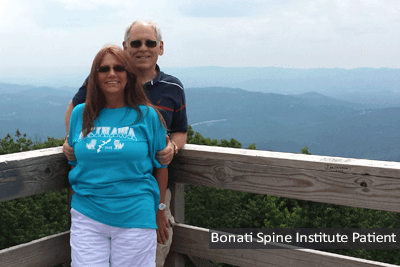Spinal Stenosis Surgery & Treatment Options
Spinal Stenosis Surgery is a safe and effective way to resolve the symptoms associated with spinal stenosis. Surgery may be necessary if conservative treatment options failed to alleviate the associated symptoms. Treatment options for spinal stenosis range from conservative to the more aggressive and often depend on the severity of the symptoms. Non-surgical treatments for the condition may include: physical therapy, back exercise or pain management with medication.
Physical therapists often direct patients to engage in back exercises developed to alleviate these symptoms. These back exercises commonly include a combination of specific stretching and strengthening routines. Forward bending exercises increase the size of the compressed passageways providing temporary relief from pain and strengthening the surrounding muscles to improve stability.

It is important to remember that, although these conservative remedies may be helpful in alleviating some spinal stenosis symptoms, they fail to address the underlying pathology driving the symptoms and are not curative.
In the event that the symptoms have reached a level where the condition is debilitating and non-surgical treatments have failed to alleviate pain, surgery for spinal stenosis treatment may be required for long term relief.
Since spinal stenosis is at its core a condition that compresses the spinal canal, any surgery for spinal stenosis would have to relieve that compression in order to alleviate the symptoms associated with it.
The primary goal of any decompression surgery of the spine is to provide additional space for the constricted spinal cord or nerve roots to pass through. Once this space has been opened up, the pain, inflammation, and numbness associated with spinal stenosis should subside. A successful decompression surgery for spinal stenosis will also return any lost mobility or motor skills associated with the condition.
When spine surgery is concerned, bear in mind that traditional open back surgeries are highly invasive, and involve longer hospital stays and recovery time due to massive tissue and muscle damage. In contrast, the advanced Bonati Spine procedures are performed on an outpatient basis under local anesthesia with patented instruments which result in same-day pain relief.
The Bonati Spine Procedures For Spinal Stenosis
Our surgeons may perform a combination of the patented Bonati Spine Procedures in an attempt to decompress the affected area and treat spinal stenosis. These procedures may include:
Foraminotomy for Spinal Stenosis
A foraminotomy is a decompression surgery performed in order to increases the space of the foramen and hollow out the passageway where the nerve roots exit the spinal canal. The procedure involves the removal of bone or tissue that obstructs the neuroforamen and compresses the nerve roots leading to inflammation and radiating pain. The removal of part of the lamina is often necessary for the surgeon to gain access to the affected nerve roots in the neuroforamen. For this reason the foraminotomy is often performed in conjunction with a laminectomy or laminotomy.
Laminectomy for Spinal Stenosis
A laminectomy is a surgical procedure performed to treat spinal stenosis. The surgery is designed to relieve pressure (decompress) on the spinal cord or spinal nerve roots through the widening of the spinal canal. The procedure is carried out by removing or trimming part of the lamina (roof) of the vertebrae in the compressed area. The removal of part of the lamina creates an opening for the compressed nerves, relieving pressure on the nerve roots and reducing inflammation. The partial removal of the lamina may also allow the surgeon to remove any bone spurs or damaged tissue causing pain and inflammation in the patient.
Laminotomy for Spinal Stenosis
A laminotomy is a common decompression surgery for spinal stenosis that resembles the laminectomy in its goals and technique. The difference between the laminectomy and the laminotomy is that the laminotomy involves making an opening in the lamina to gain access to the disc, where the laminectomy necessitates the removal of the lamina section of the vertebrae. In either case the goal is similar, to relieve pressure on the affected area and allow the nerve roots room to heal. Both procedures are often utilized in order to give the surgeon the proper space to perform the foraminotomy.
Cervical Spinal Stenosis Treatments
Treatment options for cervical spinal stenosis are similar in many respects to general spinal stenosis. Doctors often pursue conservative treatments such as stretching, exercises to strengthen the neck and back or pain management with medication in an attempt to manage symptoms short of a surgical option. However, in some patients the pressure on the spinal cord creates symptoms far too painful and debilitating to lead a productive life. In these cases a surgical procedure is necessary to correct the underlying pathology and relieve the patient from pain.
Cervical Spinal Stenosis Surgery
The Bonati Spine Institute has a 30+ year record of developing and performing groundbreaking procedures to treat cervical spinal stenosis and relieve chronic neck pain and other symptoms associated with the condition. The Bonati procedures are performed in an outpatient setting using a mild sedative and demonstrate a minimally invasive approach to treating neck stenosis. All procedures are endoscopic laser spine surgeries performed with patented instruments designed to minimize tissue damage, blood loss, and recovery time when compared to traditional open spine surgery.
Cervical spine surgeries performed at the Bonati Spine Institute to treat chronic neck pain are similar to those described for spinal stenosis. The decompression surgeries performed include the decompressive laminectomy, foraminotomy, and laminotomy.
The Bonati Spine Institute encourages patients with spinal stenosis to contact us to request a no-obligation MRI review or discuss your conditions with our medical professionals. Find out why The Bonati Spine Procedures are considered to be among the world’s best solutions when it comes to advanced spine surgery. Your pain from spinal stenosis can become a thing of the past.
